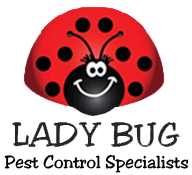DIY Tips

Sticky Traps: These traps can be made in a particular color that's coated with a sticky substance that are used to catch insects that are attracted to that color. To be effective, the traps must be clean and sticky. Also, use at least one trap (hung at plant height and close to the plant) every 3 to 5 feet.
You can buy packaged sticky traps or make them yourself. To make your own, use any rigid material of the right color (for colors, see below) or that you can spray paint. Cut the material to size (4 ✕ 6-inch rectangles are the standard), and if needed, paint it the correct color. Cover the trap with a plastic bag or clingy plastic wrap, then coat it with a sticky substance, such as Tangle-Trap. (The plastic wrap makes cleanup easy—when your trap is covered with bugs, just remove the plastic and rewrap the trap with a new piece of plastic. Then coat it with more sticky stuff.)
For cucumber beetles, use a mobile trap: Wrap clingy plastic food wrap around a white bucket or other large object, then coat the plastic with Tangle-Trap. Carry the bucket along the rows of vines, shaking and brushing the plants as you go. The beetles will fly up and stick to the traps. This a great way to do organic pest control in your garden or yard.
Colors for Sticky trap: Yellow traps attract whiteflies, fruit flies, male winged scales, leafhoppers, fungus gnats, midges, male winged mealybugs and leafminers, thrips, psyllids, and winged aphids. White traps lure whiteflies, plant bugs, cucumber beetles, and flea beetles. Light blue traps attract flower thrips, and red spheres attract the flies whose eggs hatch into apple maggots.
Insecticidal Soap : Insecticidal soap dissolves the cuticle (skin) of insects.
Mix 1 teaspoon of powdered cayenne pepper with 1 quart of water. Then add 1 tablespoon of liquid dish soap in a spray bottle and label the bottle.
To be effective, the insecticidal soap must come in contact with the insects while it's still liquid. Spray only on pests and try to avoid hitting beneficial insects with the spray. Don't spray on hot days, and rinse the soap off your plants after a few hours if the plants are receiving a lot of sunshine. If you have hard water, mix the soap with distilled water to help the soap dissolve.
Pests controlled: Insecticidal soap sprays are highly effective against mites, aphids, whiteflies, and other soft-bodied insects as well as the softer nymph stages of some tough-bodied bugs.
To minimize potential harm to beneficial insects, limit your spraying to small areas where you can see pests lurking, and leave a couple of unsprayed "refuges" for any good bugs you can't see. Protect nectar-feeding beneficials by not spraying during peak flowering times and by not spraying blossoms. Spray early in the morning, before bees become active.
If you are experiencing pest issues that you need professional help, Contact Lady Bug Pest Control Specialists, the Organic Pest Control Company for a Free Home Inspection for Termites, Eco-Friendly Pest Control, Home Seal Service, Bed Bug Eco-Heat, and Rodent Control. We perform Complete Home Inspections. Lady Bug also will do a free inspection if you already are under contract with another company and take over your existing termite warranty policy. Please feel free to contact Lady Bug Pest Control Specialists to answer any of your pest control questions or for a FREE Inspection. 480-833-1111.







